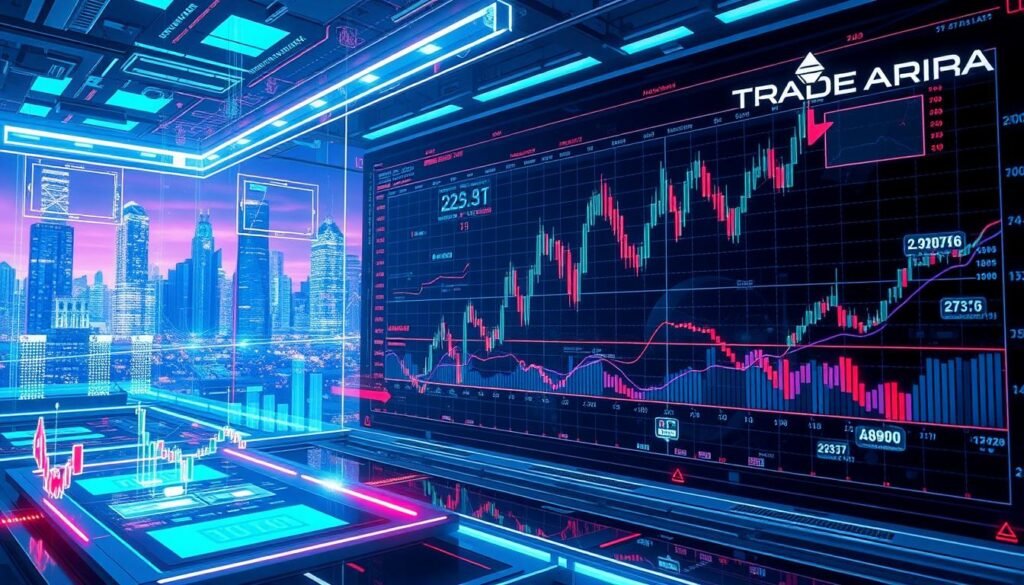In today’s fast-changing financial world, traders and investors are always looking for new ways to succeed. This article looks at the latest trading strategies that can help you move forward with confidence. We’ll cover everything from algorithmic trading to the use of machine learning and artificial intelligence.
Technology is changing how we analyze and deal with the markets. It’s important for traders to keep up with these changes. This article will show you the newest trading strategies. It will help you make smart choices and take advantage of the financial world’s shifts.
Key Takeaways
- Discover the power of algorithmic trading and how it can provide a competitive edge in the markets.
- Explore the role of machine learning and predictive analytics in uncovering hidden market trends and patterns.
- Learn about the benefits of quantitative strategies and the importance of backtesting and portfolio optimization.
- Understand the impact of high-frequency trading and the need for speed in today’s fast-paced markets.
- Delve into the integration of artificial intelligence and automation in trading, and the implications for the future of the industry.
The Future of Financial Markets
The world of finance is changing fast, thanks to technology. Traders and investors need to keep up with new tools and techniques. This will help them stay ahead in the financial markets.
The Evolution of Trading Strategies
Trading has changed a lot, moving from old ways to algorithmic trading and machine learning in finance. These new methods help traders make better choices and act quickly. They can spot trends and make trades fast and accurately.
Harnessing Technology for Competitive Advantage
Using predictive analytics and future trading strategies can open up new chances. It helps traders understand data, find patterns, and make smart moves. Technology is key for those who want to succeed in the markets.
As finance keeps changing, using new tech is crucial for lasting success. By keeping up with these trends, traders and investors can improve their performance and profitability.
Algorithmic Trading: The New Frontier
The financial markets are changing fast, and algorithmic trading is leading the way. This new method uses machine learning in finance and predictive analytics to analyze huge amounts of data. It finds patterns and makes trades quickly and accurately.
These trading programs make fast decisions, catching market changes and chances that humans can’t. They use quantitative strategies to possibly beat old trading ways. This opens up new chances for making money and managing risks.
But, algorithmic trading comes with its own set of problems. There are rules to follow, complex tech, and risks of bad outcomes. It’s crucial to watch over these systems closely and make sure they’re fair and right.
As markets get more connected and data-focused, algorithmic trading’s appeal grows. With technology, smart investors can get an edge and keep up with the financial world’s fast pace.
Machine Learning in Finance: Predictive Analytics
In the fast-paced world of finance, machine learning and predictive analytics are changing the game. These technologies help traders and investors find hidden patterns in big data. This lets them make better choices and understand the market better.
Uncovering Hidden Patterns and Trends
Machine learning algorithms can go through huge amounts of financial data. They find connections and patterns that humans can’t see. This way, financial experts can predict market changes, spot risks, and find new chances.
Machine learning in finance is used in many ways, including:
- Portfolio management – Improving how assets are chosen and risks are managed
- Algorithmic trading – Creating systems that trade fast and accurately
- Fraud detection – Finding and stopping financial crimes
- Market forecasting – Guessing future market trends and ups and downs
By using machine learning and predictive analytics, financial groups and traders can stay ahead in today’s fast markets.
The financial world is always changing. Machine learning and predictive analytics will keep being key in making trading and investment choices.
Quantitative Strategies: A Data-Driven Approach
The world of financial markets is changing fast. Quantitative strategies are now key in trading. They use data and math to make smart choices, not just guesses.
Backtesting and portfolio optimization are at the core of this change. These methods help traders make better decisions.
Backtesting and Portfolio Optimization
Backtesting is a key step in creating a good strategy. It tests a trading system with past data. This way, traders can see if it works and make it better before using real money.
Portfolio optimization is also important. It helps spread investments across different assets. This balances risk and reward, making trading more stable and profitable.
Quantitative strategies are now crucial for traders. They use data and new tech to stay ahead. This helps traders grow and succeed in the markets.
Future Trading Strategies: The Key to Success
In the world of finance, success in trading comes from a mix of things. Knowing the latest trends, using new technologies, and always improving are key. These steps help traders succeed in the changing markets of tomorrow.
Algorithmic trading is at the core of future strategies. It uses machine learning and predictive analytics for deep insights. With quantitative strategies, traders find hidden trends, making better decisions in volatile markets.
The use of artificial intelligence and automated systems has changed trading. These tools bring consistency and efficiency. They help traders avoid emotional mistakes, leading to stronger strategies.
Success in trading means always being ready to adapt and lead. Traders must keep learning and improving. By using machine learning in finance and predictive analytics, they can thrive in the future’s markets.
- Keep up with trends and tech in finance
- Try new strategies to find the best one
- Use data to improve and stay ahead
- Work with humans and machines for better trading
By focusing on these areas, traders can fully use future strategies. They will be ready for the financial markets’ changes.
High-Frequency Trading: The Need for Speed
In today’s fast world, quick trade execution is key. High-frequency trading, with its use of algorithms and artificial intelligence, is changing the game. This part explores the tech that makes speed crucial in finance.
Millisecond Advantages in a Competitive Landscape
High-frequency trading has changed market dynamics. Traders use smart algorithms and fast computers to spot and grab quick market chances. They can beat others by a fraction of a second, gaining a big edge.
This drive for speed has pushed for new tech, like super-fast networks and AI-powered trading tools. Companies with these tools can make better choices and trade faster, giving them a leg up.
High-frequency trading’s effects are wide, touching on market liquidity, price setting, and market flow. Knowing how it works is key for anyone wanting to succeed in today’s trading world.
- Algorithmic trading is key in high-frequency trading strategies.
- Artificial intelligence helps create smarter trading algorithms.
- The need for speed drives tech and infrastructure improvements.
As markets keep changing, staying ahead in high-frequency trading is vital. By using the newest tech and understanding this fast-paced field, traders can thrive in the future.
Artificial Intelligence in Trading: The Future is Here
In the fast-changing world of finance, artificial intelligence (AI) is making a big impact. It’s changing how traders work with the markets. AI algorithms and automated systems are opening up new ways to analyze data, find patterns, and make quick decisions.
The growth of artificial intelligence in trading has brought a new level of market insight. Complex algorithms can go through huge amounts of financial data. They find trends and chances that might miss even the most experienced traders. Machine learning in finance helps these systems get better over time, making smarter choices.
At the heart of this change are automated trading systems. These are computer programs that can make trades on their own. They react fast to market changes and make trades quickly. These AI and machine learning-powered systems could change trading forever, making it more consistent and efficient.
The future of trading looks bright with AI. It will bring better analysis, risk management, and less bias. The financial world is on the verge of a big change. It will mix human skill with AI’s precision, changing what makes a good trading strategy.
The future of trading is already here, thanks to AI and the financial markets. As traders and financial groups use these advanced technologies, the industry will see a big change. This will lead to a new era of trading success and market leadership.
Automated Trading Systems: Consistency and Efficiency
In the fast-changing world of financial markets, automated trading systems have changed how traders work. These systems use algorithmic trading and artificial intelligence in trading. They make trades without human emotions, bringing consistency and efficiency that’s hard to get by hand.
Removing Human Emotion from the Equation
Automated trading systems are great because they take out human feelings. Feelings like fear, greed, and doubt can mess up even the best traders. These systems use algorithms and data to make decisions, keeping trading steady and smart.
These systems can act fast, making trades quickly and accurately. This is key in fast and unpredictable markets where quick decisions are crucial. It’s hard for humans to keep up with this speed and precision.
Also, these systems watch the markets all the time, looking at lots of data and adjusting strategies as needed. They can spot chances that humans might miss. This makes them very good at finding and using market opportunities.
The financial world is getting more tech-savvy, and automated trading systems are becoming more popular. They offer traders a powerful tool to handle market complexities and maybe find new success paths.
Risk Management in the Age of Automation
The financial markets are changing fast, and automated trading systems are becoming more common. These systems bring many benefits, like better efficiency and consistency. But, they also bring new challenges for managing risks.
Traders and investors need to watch their strategies closely to manage risks. Automated trading systems must match the risk level and goals of each trader or investor.
Effective risk management in automated trading systems includes using strong portfolio optimization methods. By spreading investments and balancing assets, traders can make their portfolios more stable. This helps them handle market ups and downs better.
Stress testing and scenario analysis are also key. They help find weak spots in trading systems. This lets traders fix issues before they become big problems. It keeps them ready for market changes.
Using automated trading systems well is key to handling today’s financial markets. By focusing on risk management and seeing the big picture, traders can get the most from automation. They can also avoid big risks.
- Implement robust portfolio optimization techniques to diversify investments and manage risk.
- Regularly conduct stress testing and scenario analysis to identify potential vulnerabilities in automated trading systems.
- Maintain a holistic view of trading operations and prioritize risk management in the age of automation.
Regulatory Challenges and Ethical Considerations
Financial markets are changing fast with new tech like artificial intelligence (AI) and automation. Regulators and experts are facing big challenges. They need to balance innovation with keeping the markets fair. This part looks at the rules and ethics of using AI in trading.
Maintaining Trust and Transparency
Transparency is key for a healthy financial system. Rules need to be clear on AI and automated trading. People must trust that these new strategies are fair and reliable.
Regulatory challenges mean setting up strong rules for reporting, audits, and sharing information. This helps keep trust and transparency alive.
- Ensuring algorithmic trading systems are transparent and accountable
- Addressing ethical considerations around the use of artificial intelligence in trading
- Developing regulatory guidelines to maintain market integrity and stability
The financial world is getting more tech-savvy, but ethics must not be forgotten. Everyone needs to work together to keep the markets safe for all.
Collaborative Intelligence: Humans and Machines
In the fast-changing world of financial trading, the future is bright for those who use artificial intelligence and automated systems. The real game-changer is collaborative intelligence. This is when humans and machines team up to make better trading decisions.
By combining human smarts with tech power, traders can create stronger trading plans. This partnership lets humans use machines’ speed and pattern-spotting skills. At the same time, machines get to tap into humans’ deep understanding and problem-solving abilities.
The future of trading is all about blending artificial intelligence in trading, automated trading systems, and collaborative intelligence. As markets get more complex and unpredictable, the mix of human and machine smarts will guide us through. It will help us tackle challenges and grab new opportunities.
- Harnessing the Power of Collaborative Intelligence
- Leveraging Human Expertise and Machine Capabilities
- Developing Robust and Adaptive Trading Strategies
- Navigating the Complex and Volatile Financial Markets
By teaming up humans and machines, traders can lead the way to success. The future of trading isn’t about machines taking over. It’s about humans and machines working together to push the limits of what’s possible in finance.
Developing a Winning Trading Strategy
The financial markets keep changing, making a good trading strategy more important than ever. To reach your full potential, you need to know your goals and risk tolerance. By matching your strategy to your investment goals and how much risk you can take, you can achieve steady growth over time.
Identify Your Goals and Risk Tolerance
Before starting your trading journey, it’s key to clearly define your financial goals. Are you looking for steady returns or are you okay with taking more risk for bigger gains? Your strategy should fit your needs and risk level. Remember, everyone’s path to success is different.
- Set your short-term and long-term investment goals
- Figure out how much risk you can handle and how much you’re willing to take
- Use the latest risk management methods to protect your investments
- Apply portfolio optimization strategies to increase your returns
By carefully thinking about your goals and risk tolerance, you’re on the right track. This will help you create a future trading strategies that meets your needs. This foundation will be the base of your journey to trading success.
Continuous Learning and Adaptation
In today’s fast-changing financial markets, the key to success is learning and adapting constantly. As technology and trends move quickly, traders who keep learning can handle market challenges better. They become more agile and resilient.
To stay ahead, traders need to be proactive about learning. They should spend time on the latest in trading tech, tools, and rules. Reading industry news, going to conferences, and joining professional groups helps them stay ahead. This way, they can adapt to the market and succeed in the long run.
- Cultivate a growth mindset and a thirst for knowledge
- Continuously explore new trading strategies and techniques
- Adapt your approach as market conditions and trends evolve
- Leverage educational resources and industry experts to enhance your skills
The ability to adapt and evolve is crucial for a trader’s success today. By always learning, traders can face the market’s changes with confidence. They make smart choices that lead to steady growth and lasting success.
Conclusion: Embracing the Future of Trading
The financial markets are on the verge of a big change. New technologies like algorithmic trading, machine learning in finance, and artificial intelligence in trading are leading the way. These advancements offer exciting opportunities for investors and traders.
By using these advanced tools, traders can stay ahead in the changing financial world. They can make better decisions with data and use automated systems for speed and consistency. The future of trading is full of chances for those who are ready to learn and grow.
But, we must also think about the rules, ethics, and trust in the industry. As we move forward, it’s key for everyone to work together. Traders, banks, and regulators need to make sure the markets are safe, fair, and open to all.
FAQ
What are the key trends shaping the future of trading strategies?
New technologies like algorithmic trading and artificial intelligence are changing trading. These tools help traders analyze data, spot patterns, and make quick trades. This gives them an edge in the market.
How can algorithmic trading help traders succeed in the markets?
Algorithmic trading uses computer programs to find and make trades automatically. It removes emotions from trading, allowing for faster and more precise trades. This can help traders find and use market inefficiencies.
What are the benefits of incorporating machine learning in financial decision-making?
Machine learning helps find hidden patterns in data, giving deeper insights into markets. It lets traders make better decisions and anticipate market changes. This leads to more informed and effective trading strategies.
How can quantitative strategies help traders optimize their portfolios?
Quantitative strategies use data and math to guide trading decisions. This approach helps traders test strategies, find the best times to buy or sell, and optimize their portfolios. It can lead to better returns while managing risk.
What role does artificial intelligence (AI) play in the future of trading?
AI and automated systems are changing trading. They quickly analyze data and make decisions, giving traders an edge. But, AI raises questions about regulation and ethics in trading.
How can traders effectively manage risks in the age of automation?
Managing risk is key with automated trading. Traders need to watch their systems, diversify, and understand their algorithms. This helps control risks and maintain control over trading decisions.
What are the key considerations for developing a winning trading strategy?
A winning strategy starts with knowing your goals and risk level. Tailor your approach to fit your needs. Use new tech, manage risks, and keep learning to stay ahead in the market.










Pingback: Trading Chart Analysis: Learn Technical Market Basics